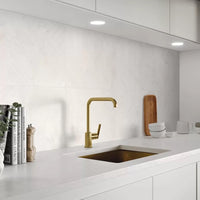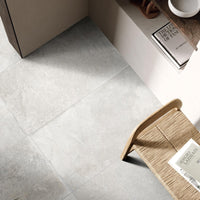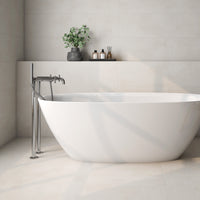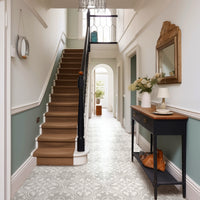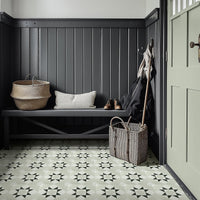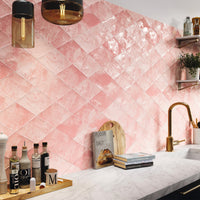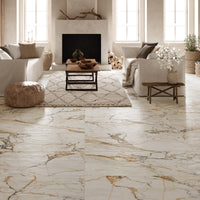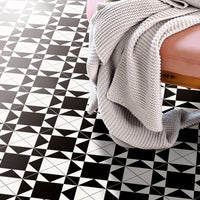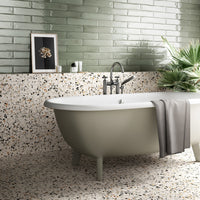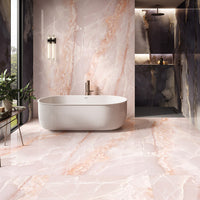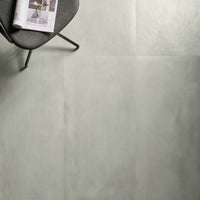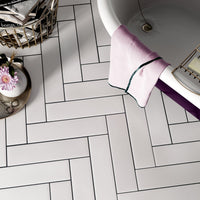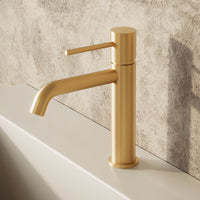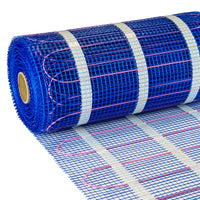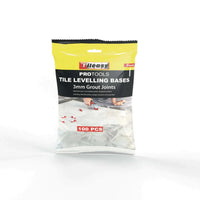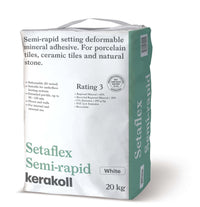Ok, admission alert. Here at Porcelain Superstore, we’re a little bit obsessed with wetrooms. In our eyes, there’s no better way to wake up; no shower more invigorating. In fact, if it was up to us we’d pass a law demanding every home should have one. And while we think that a well-planned wetroom strikes the perfect balance between form and function, it’s easy to be slightly scared. Will all that water level the towels soggy? Or - god forbid - leak downstairs? With a well planned room, the answer’s a definite no. Read on, and discover our tops tips on how to plan your perfect showering space.
What is a Wetroom?
A wetroom is just a tiled shower space that’s fully open, right? Well pretty much, but that’s not the whole story. While most wetrooms have a tiled floor that replaces the normal shower tray, not all are ‘fully open’ to the rest of the room. In fact, most have a glass screen to stops water soaking everything while maintaining that walk-in, airy showering experience. Screen or no screen, wetrooms offer a luxurious experience that’s perfect for modern lifestyles.

The Benefits of a Wetroom
Flick through properties on
Rightmove and you’ll notice that the best-dressed homes are wearing wetrooms. And while there’s always a place for a traditional bath - especially after a long day at work - a well designed wetroom elevates your morning shower from practicality to pleasure. Here’s why:
Space Saver
Let’s be honest, British bathrooms are known for being more bijou than big. But worry not; wetrooms are a saviour for those stuck on space. When it comes to conjuring up a sense of space in interiors, less is always more. So because you won’t have a bulky shower enclosure, your room will feel a lot more spacious. And by their very nature, wetrooms are ideal for trickier spaces - perfect, for example, if you’re converting a smaller room into a stylish en-suite.
Adding Value
While we’re big believers that you should design your home around you and your family, it’s undeniable that a brand-new wetroom will add value to your house. So if you’ll excuse the pun, don’t be afraid to splash out on sleek showers and attention-grabbing tiles to turn the heads of any future would-be buyers.
Cleaning
The most tedious household chore? Cleaning your bathroom, period. But with a wetroom, scrubbing your space becomes a pleasure - no, really! They’re just brilliantly practical and no enclosure means no fiddly doors to keep clean. After all, who honestly enjoys mouldy mildew? Our hot tip? Add a hand shower if you can - they’re make rinsing the tiles and glass screen a doddle.
Spa Sensations
Being the compulsive Pinterest-ers that we are, we’ve spotted a trend for indulgent showers in the latest designer hotels. But why splash out on a boutique bolthole when you can have a stylish, spa-like space at home? By their very nature, wetrooms have a luxurious, airy ambiance; add in oodles of hot water and some scented soaps for a shower that’s both refreshing and relaxing.
Accessibility
It’s easy to be seduced by the super modern aesthetic of wetrooms, but you shouldn’t overlook their practical benefits. As the floor tiles seamlessly continue into the shower, there’s no step up - so no trip hazard, in other words. We like to think of this as effortless luxury for modern living and it’s perfect if you’re elderly, disabled or have small children.
First Things First...
Tempted by the benefits of a contemporary wetroom? Great! Now it’s time to roll up you sleeves and get to the nitty gritty. As with bathrooms, creating your perfect shower can be pretty complex but don’t be overwhelmed - we’re here to help. Here’s a few things to do before making any big decisions.
1. Think about your current bathrooms and your lifestyle. For instance, if you’re a lover of long soaks then removing the tub is a no-no, so why not convert a smaller room into a wetroom? Now consider the practicalities of the space; would a glass screen prevent the rest of the room from getting wet?
2. To help narrow down the style you like, start making moodboards of designs and colours you like -
Pinterest is a great place to collate ideas and images. Wetrooms should feel modern and airy, not dated and boxed-in; so look to conceal pipework and remember that sticking to one uniform colour will give that minimal, hotel-style effect.
3.. Forgive us for stating the obvious, but it’s a wise idea to set a budget and time frame. From our experience, fitting a wetroom takes around two to three weeks but you may need to allow longer, especially if you’re converting from another room.
4.. Even if you’re a seasoned DIY-er, some things are best left to the pro’s. Wetrooms are one of the most complex projects you can undertake, so insist on using a plumber with experience - the trays in particular can be a little tricky to install. Be sure to ask for references of recent work and agree on a payment schedule before committing.
The Plumbing
It goes without saying that the pipes and valves are the nuts and bolts of any bathroom! Before making any style choices, there’s a few things you’ll need to bear in mind.
Waste Pipe
The key consideration in your new wetroom? Sadly it’s not which rain shower to plump for; instead it’s the location of your waste pipe. This carries waster water from the basin, loo and shower and you’ll usually need to design your layout around it. In addition, if you’re refurbishing an existing bathroom it’s probably best to keep the toilet in its current spot.
Water Pressure
Although many of us dream of a deluge of water from a rainfall shower head, it’s not always possible. So before picking any brassware, you’ll need to know if you’ve got a high or low pressure system. Some showers will need a minimum water pressure to work properly - if you’re not sure, it’s best to ask your installer. And If you don’t have a combo boiler - which produces hot water on demand - you’ll want to make sure you’ve got enough storage. After all, you don’t want to run out during the morning shower rush!
Drainage
Sure, thinking about drainage might be a little unsexy but then again, who likes a flooded floor? Certainly not us. The most popular way to build a wetroom is by using a formed shower base with a build-in gradient towards a drain. Your tiles are cut and placed to follow this slope, so that the water quickly runs away. It’s pretty straight-forward but if you’re installing a power shower it’s best to check the flow-rate of the drain. After all, you don’t want water pooling up around your feet!
Level Access The classic way to work a wetroom is by having a fully flush floor so there’s no step into the shower. This is the perfect marriage of sleek looks and practicality, but it’s not always possible. In some houses, the floor joists might not be deep enough to recess the wetroom tray, so you’ll have to have a step up. But don’t fret - mosaics and contrasting tiles can be used to turn this step into a standout feature.
Waterproofing
It goes without saying but with all that water, it’s vital that your walls and floors are protected. Here’s what you need to know.
Building Boards
Most pre-formed wetroom trays are made from a rigid foam that’s waterproof and perfect for tiling onto. These are perfect for your shower space, but there’s still the question of your remaining floor and walls. For ultimate peace of mind, we’d recommend using our Delta building boards, which are made from a similar material and can be used to clad the rest of the space.
Tanking
Even if you use waterproof building boards rather than tiling to porous plaster or ply, it’s still essential to seal your space. Waterproof compounds can be applied to walls and floors (or just the joints if you’re using waterproof boards) to create a protective, waterproof barrier. We’d recommend applying two coats - the second at ninety degrees to the first - just for extra peace of mind.
Glass Screens and Partitions
Although a fully open shower is the dream for many of us, in our experience the majority of wetrooms contain a screen or partition wall. In both cases, the aim is to contain splashes and stop water flowing all over the room. As you might expect, glass screens are the more popular choice, as they offer a contemporary and airy style. However, don’t dismiss tiles partition walls - they still offer the walk-in feel yet can section off your shower space in dramatic style. Why not clad the room-facing side in eye-catching patterned tiles?
Tiles
Putting any bias to one side, tiles are the perfect material for your new wetroom. At the end of the day, it’s going to be a very liquid environment; your walls and floors need to withstand this water and humidity. So it’s a wave goodbye to real wood and a no for natural stones; porcelain tiles are the ideal choice. No only are they virtually waterproof, the latest
wood and
stone-effect tiles look so good realistic you’d be pressed to notice any difference. For a truly modern look, continue your floors onto your walls; larger tiles will enhance the seamless style. Smaller tiles and mosaics are a great choice for the shower floor itself - with more grout joints you’ll naturally gain more traction underfoot.
Underfloor heating
Call us opinionated, but we think 100% of wetrooms should have underfloor heating mats. Not only do they keep the chill off tiles, the heat will help puddles dry far quicker than usual - no-one wants to get soggy socks from brushing their teeth after someone’s had a shower! So while underfloor heating isn’t waterproof per se, it’s a really good thing to have to keep your room nice and dry.
The Rest Of Your Room
While the shower in your new wetroom is likely going to be the main event, you’ve still go the rest of the room to think about. There’s tiles and colours to think about, along with basins, storage and loos. Oh, and perhaps a bath too - confusingly, plenty of wetrooms are also actual bathrooms!
Storage
Even if your wetroom isn’t your main family bathroom, storage is still just as crucial. And while there’s no right and wrong, we think wetrooms always look their best when clutter free - so put on your minimal mindset and just keep the products you’ll use every day. The key is to design in storage right from the start so it’s not an afterthought. For example, niche shelving in the shower area is great for soaps and shampoos, and won’t hem you in like chrome racks. Modern, wall-hung basin units will create an illusion of space so they’re great for smaller spaces; space-saving floating toilets are also a great, contemporary choice.
Style
In the not-so-distant past, decor options for the average bathroom were pretty limited - it was more a case of function first, style second. Thankfully times have changed and there’s a wealth of designer tiles, boutique-y brassware and fresh furniture options available. But while it sometimes pays to think outside the box and go a little funky, it’s more than likely that you’ll be using your new room daily. So with that in mind, we’d stick to safer, timeless tones. However, safe doesn’t have to mean boring; in fact there’s a whole range of neutral shades that look effortlessly great. If you’re after a high-end hotel feel, you really can’t beat white marble tiles such as Timeless White. At the other end of the spectrum, dark grey concretes offer a cool, minimal style that transcends trends. At the end of the day, this is your bathroom so opt for something you love! Just remember that in smaller spaces, less really is more - clean lines, wall-hung furniture and reflective surfaces will all enhance the illusion of space.
One Last Thing
Jostling for the bathroom isn’t fun - especially during busy mornings. So why not take inspiration from boutique hotels and opt for his-and-hers showerheads? While we don’t have hard evidence, we’re pretty sure that doubling up is good for matrimonial harmony. For the full spa-like experience, opt for super-size heads and add in body jets for the wow-factor.

